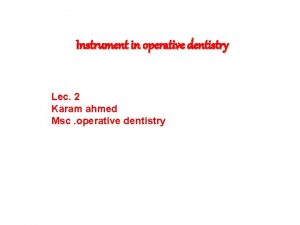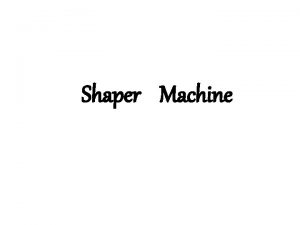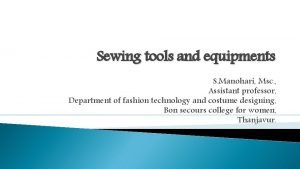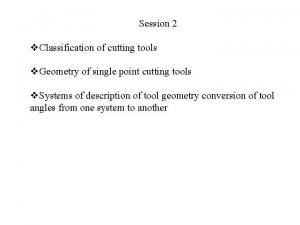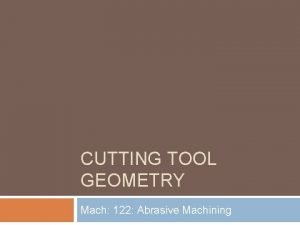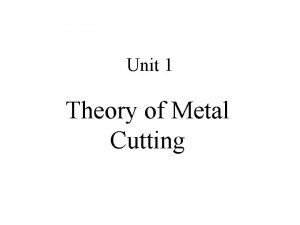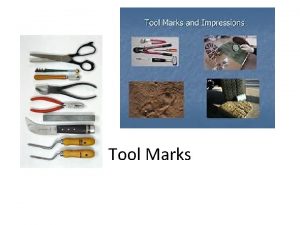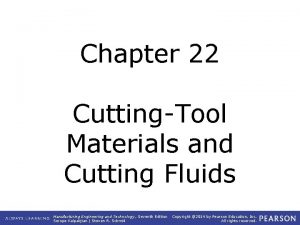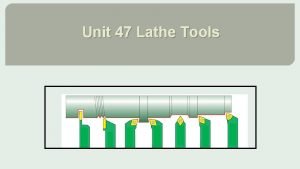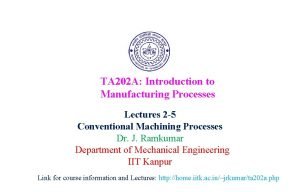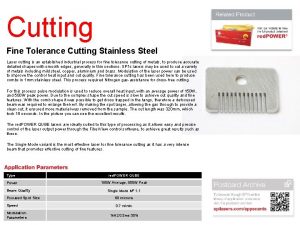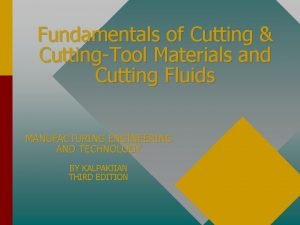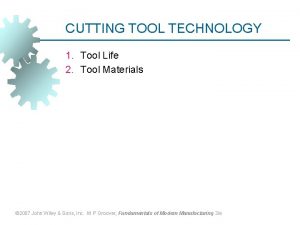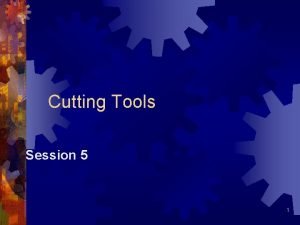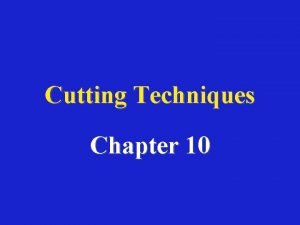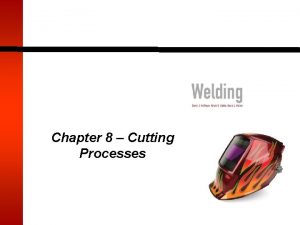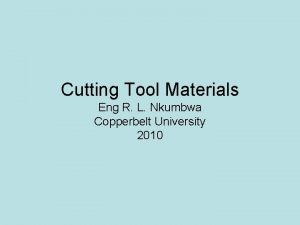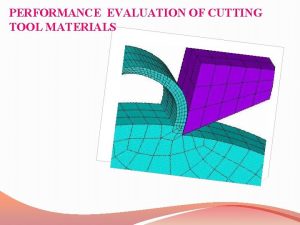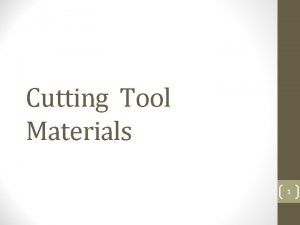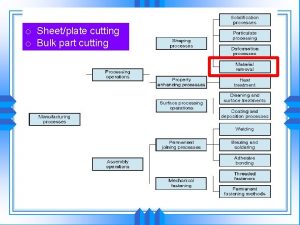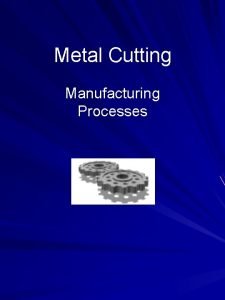Chapter one Cutting Tool Materials Machine Tool machine





























- Slides: 29

Chapter one Cutting Tool Materials

Machine Tool • machine tool is a power operated, non-portable and valuable machine that can perform multiple machining operations by remove excess material from a pre-formed blank with the help of a suitable cutting tool. • machine tool is strictly restricted within the metalworking (or machining) field. • So a machine having following five characteristics can be considered as a machine tool.

• It must be power driven (human operated machines are not machine tools). The form of power at input to the machine tool can be either electrical, mechanical, hydraulic, pneumatic or a non-conventional one. • It must be non-portable (portability irrespective of size). Thus machine tools are always firmly installed with the shop floor. • It must have sufficient value (value in terms of capability and performance; not on the basis of cost). • It can perform more than one machining or metal cutting operations. • It utilizes a cutting tool to shear off excess materials from workpiece.

• If and only if all of the above five conditions are satisfied then a machine can be called a machine tool. • Examples of machine tool include Lathe machine tool, Milling machine tool, Shaping machine tool, drilling & boring machine tool, etc.

Cutting Tool • A cutting tool is a small device having one or more wedge shaped and sharp cutting edges to facilitate shearing during metal cutting. • So a cutting tool basically removes (shears off) material from workpiece. • It is rigidly mounted on the machine tool in appropriate location. • Shape and features of the cutting tool varies widely based on the required machining operation and intended performance.

• Cutting tool cannot provide any motion required for cutting. All intended motions are provided by the machine tool. • So cutting tool is mounted on a machine tool using suitable tool holding arrangements so that it can compress a thin layer of workpiece material to gradually shear it off in the form of chips for material removal. • For example, lathe is a machine tool, while the SPTT (single point turning tool) is a cutting tool.

Types of Cutting tool • According to the number of active cutting edges engaged in cutting: v. Single-point cutting: – The cutting tool has only one major edge. – Examples: turning, shaping and boring. v. Multipoint cutting: – The cutting tool has more than one major cutting edge. – Examples: drilling, milling, and reaming.

The following table displays several machine tools and typical cutting tools that can be mounted on corresponding machine tools.

Properties of cutting tool materials • Hardness: The tool material must be harder than the work piece material. • Hot hardness: ability of the cutting tool to maintain its hardness and strength at elevated temperatures. • Toughness: to resist shock • Low coefficient of friction at the chip tool interface, so that the surface finish is good and wear minimum. • Wear resistance: to maximize the lifetime of the tool. • Thermal conductivity: higher thermal conductivity to reduce cutting temperatures near the tool edge. • Chemical inertness of the tool material with respect to the work material to resist diffusion, chemical and oxidation wear.

Cutting Tool Materials • • • Carbon and medium alloy Steels High Speed Steel(HSS) Cemented Carbides Ceramics Polycrystalline Diamonds Cubic Boron Nitride (CBN)

Carbon and medium alloy Steels • High carbon tool steel is the oldest cutting tool materials, having carbon content ranging from 0. 7 – 1. 5%. • Inexpensive, easily shaped, sharpened. • Maximum hardness is about HRC 62 and hence has low wear resistance • It has low hot hardness-poor properties above 200 OC. • Limited to low cutting speed operation (9 mm/min). • Uses: Drills taps, broaches , reamers for machining soft materials and wood working tools

High Speed Steel (HSS) • high speed tool steel consists of alloying elements (manganese, chromium, tungsten, vanadium, molybdenum, cobalt, and niobium) to harden and strengthen the steel and make it more resistant to heat (hot hardness). • Can be hardened in the range of HRC 63 -65. (hardenability is good) • Due the presence of cobalt, HSS cutting tools retain the cutting ability up to 600 OC • The high toughness and good wear resistance make HSS suitable for all type of cutting tools with complex shapes for relatively low to medium cutting speeds.

High Speed Steel (HSS) • Two basic types (AISI) 1. Tungsten‑type, designated T‑ grades 2. Molybdenum‑type, designated M‑grade M-series - Contains 10% molybdenum, chromium, vanadium, tungsten, cobalt • Higher abrasion resistance • H. S. S. are majorly made of M-series T-series - 12 % - 18 % tungsten, chromium, vanadium & cobalt • undergoes less distortion during heat treating • Uses: Drills, reamers, broaches, milling cutters, taps, lathe cutting tool, gear hobs etc. are made of HSS.

Cemented Carbides • Also Called as Sintered Carbides • It consist of heat-resistant refractory carbides (hardness) embedded in a ductile metal matrix (toughness). • Refractory carbide used: – tungsten carbide (WC), – tantalum carbide (Ta. C), – titanium carbide (Ti. C). • Cobalt is used as binder • These tools are produced by powder metallurgy.

Cemented Carbides • Most widely used cutting tool today because of their high hot hardness and wear resistance. • They are able to retain hardness to a temperature of about 10000 C. So they can be used at high speeds. (3 to 5 times faster than HSS. ) • The main disadvantage of cemented carbides is their low toughness. • They are extremely brittle and weak in their resistance to it impact and shock loading. • Due to the high cost of carbide tool materials and other factors, cemented carbides are used in the form of inserts

Cemented Carbides Types based on ISO: P, M and K. ISO P: is for the machining of long chip formation materials. (Ferrous) ISO M: is for the machining of difficult to machine materials such as austenitic stainless steel, high temperature alloys etc. ISO K: is for the machining of short chip formation materials such as cast iron, hardened steel.

Ceramics • also known as Cemented Oxide • Ceramic tools are composed primarily of fine-grained, highpurity aluminum oxide (Al 2 O 3), pressed and sintered at high pressures and temperatures into insert form with no binder. • There is no occurrence of built-up edge, and coolants are not required. • The strength of ceramics under compression is much higher than HSS and carbide tools. • It has high hot hardness (up to 1200 degree ), so capable of running at high speeds. (3 times faster than carbides ) • Ceramic tools have poor thermal and shock resistance and are not recommended for interrupted cuts.

Cubic Boron Nitride • Next to diamond, cubic boron nitride (CBN) is hardest material known. (1962) • CBN(polycrystalline structure) is used mainly as coating material because it is very brittle. Coated on WC‑Co inserts • This tool material maintains its hardness and resistance to wear at elevated temperatures (1000 o. C) and has a low chemical reactivity to the chip/tool interface. • Typically used to machine hard aerospace materials (nickel‑based alloys). • Cutting speeds and metal removal rates are up to five times faster than carbide.

Polycrystalline Diamonds • Sintered polycrystalline diamond - fabricated by sintering very fine‑grained diamond crystals under high temperatures and pressures into desired shape with little or no binder • Usually applied as coating (0. 5 mm thick) on WC-Co insert • Used with or with out coolant • Applications: high speed machining of nonferrous metals and abrasive nonmetals such as fiberglass, graphite, and wood

Cutting tool materials hardness and strength (a) Hardness of various cutting-tool materials as a function of temperature. (b) Ranges of properties of various groups of materials.

Tool Life • Tool life is the time a newly sharpened tool cuts satisfactorily before it becomes necessary to remove it for regrinding or replacement. • Tool life is defined as the cutting time to reach a predetermined amount of wear. • This amount of acceptable wear is called the tool wear criterion. • When the tool wear reaches an initially accepted amount, there are two options, � To resharpen the tool on a tool grinder � To replace the tool with a new one

Tool life equation • Tool life equation is a empirical relationship between the tool life and one or more variables of cutting parameters • The most famous tool life equation is proposed by F. W. Taylor

Taylor Tool Life Equation This relationship is credited to F. W. Taylor (~1900) where V = cutting speed (m/min); T = tool life (min); • n is the slope of the plot • Also called tool life exponent • C is the intercept on the speed axis • Known as Taylor constant • When T=1, then C becomes the cutting speed for 1 min tool life

Taylor Tool Life Equation • n and C are parameters that depend on feed, depth of cut, work material, tooling material, and the tool life criterion used

Typical Values of n and C in Taylor Tool Life Equation Tool material n C (m/min) High speed steel: Non-steel work 0. 125 120 Steel work 0. 125 70 Cemented carbide Non-steel work 0. 25 900 Steel work 0. 25 500 Ceramic Steel work 0. 6 3000

Safety in machine shop State of Mind. Do not operate power tools when you are ill, taking strong medications, fatigued or consuming alcoholic drinks. Do not smoke while working with tools. Wear proper clothing for the type of work being done. Do not wear loose-fitting clothes or jewelry that can get caught in moving parts. Do not roll up long sleeves. Do not wear highly flammable clothes. Do not wear sandals, open-toed or canvas shoes. Wearing safety toed shoes is preferable for protection of feet and toes. Remove all jewelry, including rings, necklaces, bracelets and watches that could get caught in tooling before starting work. Safety Glasses must be worn at all times in the shop. Some operations may require additional eye protection or other personal protective equipment

Protect your eyes, face, head, and scalp. At a minimum, wear industrial-quality safety lasses with side shields. Avoid distractions. Keep your mind on your work. Talking or listening to the radio while running machinery can lead to accidents. Stop working and turn off the power tool you are working with if distracted by something or someone. Never look away from your work when operating a power tool. Keep the work area clean. Keep the floor free of scraps and oil. Cluttered work areas invite accidents. Keeping workshop and storage spaces clean and dry can help prevent many accidents. Sparks can ignite scraps, sawdust and solvents. Water can conduct electricity. Do not stand in water, on damp floors or in the rain when working with electrical tools. Keep hands and tools dry. Food and Drink are only permitted in designated areas.

Work only at operating speed. Do not use a power tool before it has reached operating speed or while it is coming to a stop. Keep tools clean and in good repair. Always clean up power tools before putting them away. Avoid using tools that are or appear to be in disrepair. Use power tools only for their intended functions. Repairing and Cleaning Power Tools. Always turn off and unplug a power tool before (1) adjusting, oiling, cleaning or repairing it; (2) attaching an accessory; or (3) changing bits, blades or grinding wheels. Do not leave a machine running unattended. Make sure all moving parts have come to a complete stop before you leave the work area or before you make minor adjustments. Know the machine. Before using any tool, read the operator's manual Know the switch location(s). Remember where the switch is located so you can turn off the machine quickly.

Machine Shop Safety Rules for Specific Power Tools Band Saws: Keep the saw blade set evenly and with the correct tension Grinders: Never operate a grinder without protecting your eyes with safety glasses, goggles, or a face shield Lathe: Before operation, lubricate the spindle bearings and the ways with the appropriate oil provided. Do not wear loose fitting clothing when operating the lathe. Milling Machine: Always wear safety glasses when using the milling machine. Before starting the machine, lubricate the machine ways with way oil.
 Marking tools in sewing
Marking tools in sewing Sample of cutting tools
Sample of cutting tools Theory of metal cutting mcq
Theory of metal cutting mcq Instrument formula of gmt
Instrument formula of gmt Modified pen grasp diagram
Modified pen grasp diagram Dental bur
Dental bur Lip angle of single point cutting tool
Lip angle of single point cutting tool Which is the reciprocating member of the shaper
Which is the reciprocating member of the shaper It has 4 to 5 inches finely tapered blades
It has 4 to 5 inches finely tapered blades Cutting in
Cutting in Lathe cutting tool angles
Lathe cutting tool angles Lip angle of single point cutting tool
Lip angle of single point cutting tool Compression tool marks
Compression tool marks Cutting tool material
Cutting tool material Types of lathe tools
Types of lathe tools Milling cutter nomenclature
Milling cutter nomenclature Sintering definition
Sintering definition One god one empire one emperor
One god one empire one emperor One one little dog run
One one little dog run One king one law one faith
One king one law one faith One god one empire one emperor
One god one empire one emperor One team one plan one goal
One team one plan one goal See one do one teach one
See one do one teach one See one, do one, teach one
See one, do one, teach one One face one voice one habit and two persons
One face one voice one habit and two persons See one do one teach one
See one do one teach one Asean tourism strategic plan
Asean tourism strategic plan Asean one vision one identity one community
Asean one vision one identity one community Cant stop the feeling go noodle
Cant stop the feeling go noodle When is a material useful
When is a material useful




